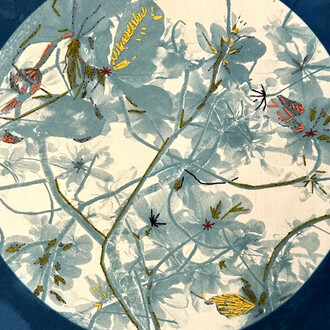Artist Adrian Yu announces the unveiling of Strata, a monumental public art installation in front of the new Mesa City Hall. Strata is a large-scale sculpture taking the form of an abstracted mountain range crafted from steel and curved LED panels, powered by generative software that visualizes real-time climate data. The sculpture, designed and fabricated in collaboration with multimedia design-build studio Digital Ambiance, draws inspiration from the natural landscape and towering peaks visible from Arizona's valleys, while prompting visitors to engage with the ongoing impacts of climate change and the city's terraforming initiatives. The sculpture's design mirrors the geological concept of strata—layers of rock that chronicle the Earth’s history—using generative technology to reflect the transformation of the planet and local area.
"Strata is a window into both the past and the future. The layers of rock in mountains tell a story of Earth's past, while this work of art tells a story of the future, using technology to visualize humanity's effect on the environment. As the work evolves over time, no two viewings will ever be the same," says Adrian Yu. "My work explores a concept I call spatial cinema, or participatory nonlinear storytelling in audiovisual environments. Through this multi-sensory work, we hope to connect the public with a bigger picture of our connection to and impact on the natural world.”
“Strata is an exceptional addition to Downtown Mesa’s cultural landscape, offering a thought-provoking experience for residents and visitors alike,” said Mesa City Manager Chris Brady. “More than adding visual appeal to our public space, Adrian Yu uses City of Mesa data to foster dialogue around sustainability in the desert landscape. We invite our residents to visit downtown and enjoy this new addition to our public art efforts.”
“For Strata, we combined research on desert landforms and geologic discourse with parametric design tools to create the spiral of deep time in bands of laser-cut steel with embedded curved LED displays.” Says Digital Ambiance Creative Director, Omer Yosef, “Synthesizing ambitious artistic concepts with architectural formal techniques and municipal codes, the work is both empirical and speculative, site-specific and ever-evolving in communication with the public. The piece is designed with special viewing angles, including a panoramic display from the front and a 250-degree West facing portal aligning with the desert sunset.”
Strata
The abstracted mountain range features three centrally positioned, tapering summits composed of automotive steel, with LED panels curving along the interiors of each arch. In a serpentine coil, the arches cast contours of light that draw the viewer into a parallaxing portal effect and collapse perspective with illusionary architecture––inviting viewers to explore different vantage points. Situated beneath the first and most prominent bend is a mirrored sphere that when viewed from the perfect angle, transforms into a silhouetted eclipse to reflect the viewer and pull them into the work. The placement of the sphere transforms the viewing experience into a participatory one. As viewers actively engage with the themes of the work, they find themselves a part of it, further symbolizing the symbiosis between man and nature.
The coiling LED panels respond to real-time climate data, allowing the generative installation to manipulate colors, shapes, and the trajectory of wind and water simulations for day and night, respectively. Its tone is entirely influenced by the city's energy and water consumption, transforming the installation into an ongoing reflection of the population’s activity. As usage patterns and energy expenditure data develops, no two viewings of Strata will ever be the same; the sculpture serving as an ever-evolving symbol of the synergy between life and technology.
Climate data visualization
Strata’s data visualization server pulls climate data from both the city’s aggregated data and local weather APIs to drive dynamic updates to the wind and water simulations displayed on the LED panels. The visuals respond in real time, generating landscapes and environments using a gaming engine.
The data endpoints include metrics such as time, temperature, wind speed, wind direction, precipitation, humidity, and air quality. Additionally, they incorporate key elements of the city’s climate initiatives, such as the number of community trees planted, water consumption, and energy usage. These data points influence the velocity, speed, direction, shape, color, and lighting of the water and wind simulations within the sculpture. An example of this integration is the Trees Are Cool initiative, which aims to plant one million trees in Mesa by 2050 to increase the city’s tree canopy and mitigate the effects of climate change. For each new tree planted, the sculpture generates visuals of spawning flora, symbolizing progress.
“Strata holds humanity accountable by incorporating the city of Mesa’s climate initiatives and utilizing data to create simulations that measure the city’s progress toward its sustainability goals,” states Yu. “It reflects both the fragility and resilience of our planet, highlighting Mesa’s ongoing evolution and our shared future.”
The data Strata utilizes reflects Mesa’s progress toward its aspirational goals, including achieving carbon neutrality and prioritizing renewable energy. This progress is visually represented within the sculpture's simulations, connecting Strata to the city’s sustainability efforts.
Strata will remain on view as a permanent public art piece in Mesa, Arizona.








